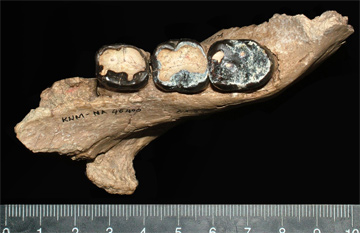Missing link between humans and apes possibly discovered
mongabay.com
November 12, 2007
A 10 million-year-old jawbone discovered in Kenya may represent a new species very close to the last common ancestor of gorillas, chimpanzees, and humans, report researchers writing in the current issue of the journal Proceedings of the National Academy of Sciences (PNAS).
A team of researchers led by Japanese archeologists found the jawbone, along with 11 teeth, involcanic mud flow deposits in the Nakali region of Kenya — the first time a hominoid fossil from this period has been uncovered in Kenya since 1982. The remains suggest the creature — named Nakalipithecus nakayamai — was somewhere between the size of a female gorilla and a female orangutan, and fed on nuts, seeds and fruit,” according to Reuters.
 Fossil jawbone of Nakalipithecus nakayamai, an ancient great ape close to the last common ancestor of gorillas and humans. Image courtesy of Yutaku Kunimatsu. |
“The teeth were covered in thick enamel and the caps were low and voluminous, suggesting that the diet of this ape consisted of a considerable amount of hard objects, like nuts or seeds, and fruit,” Yutaka Kunimatsu at Kyoto University’s Primate Research Institute told Reuters. “It could be positioned before the split between gorillas, chimps and humans,” he added.
The find supports the theory that the ancestor of African great apes and humans likely evolved in Africa, not Europe as some researchers have surmised.
CITATION: Yutaka Kunimatsu et al. A new Late Miocene great ape from Kenya and its implications for the origins of African great apes and humans. Proceedings of the National Academy of Sciences. 12-November-2007